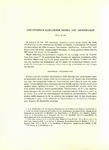| dc.creator | Δημακοπούλου, Κατερίνα | el |
| dc.date.accessioned | 2015-07-30T09:00:09Z | |
| dc.date.available | 2015-07-30T09:00:09Z | |
| dc.date.issued | 1965 | |
| dc.identifier.uri | http://hdl.handle.net/11615/14857 | en |
| dc.description.abstract | PREHISTORIC POTTERY
ON THE AREA SOUTH OF THE ACROPOLIS
(Plates 38-44)
The excavation on the Angelopoulos and Zacharatos properties, on the Boulevard
of Dionysius the Areopagite, south of the Acropolis, carried out by the
Greek Archaeological Service in 1961, yielded among the other finds, a great
quantity of prehistoric sherds. Very few of these sherds are sub-neolithic. The
others belong to the Bronze Age and may be distinguished as Early Helladic, Middle
Helladic and Late Helladic pottery. The sherds of the Early Helladic period
include those of black and red monochrome, plain and incised wares. Among the
sherds of the last ware there is a little fragment of a frying-pan (PI. 38c,5),
which if not an importation, shows Cycladic influence. The Middle Helladic
pottery predominates and includes red monochrome ware, Minyan, Matt-painted
and plain wares. The Minyan and the Matt-painted wares consist a large amount,
in comparison to all the prehistoric pottery found. The bulk of the Minyan sherds
are grey Minyan, but there are also a few sherds of yellow Minyan ware ( P 1.
41a). The only one complete vase revealed, belongs to the grey Minyan ware,
a goblet with low stem. Most of the sherds of the Matt-painted ware belong to
the coarse ware. Very few are of the fine ware and there are two sherds of polychrome
matt-painted decoration. The number of Late Helladic sherds is small in
comparison to the great amount of the Middle Helladic and Early Helladic sherds.
The most of the Late Helladic sherds belong to the LH III period.
This survey of the prehistoric pottery found south of the Acropolis shows how
important this area is. Certainly, until the entire place is investigated, no final
decisions can be made, but it is obvious now that the area south of the Acropolis
was inhabited during the Bronze Age as well as the North slope of the Acropolis. | en |
| dc.language.iso | el | en |
| dc.publisher | Υπηρεσία Αρχαιοτήτων και Αναστηλώσεως | el |
| dc.rights | Attribution-NonCommercial-NoDerivatives 4.0 International | en |
| dc.rights.uri | http://creativecommons.org/licenses/by-nc-nd/4.0/ | en |
| dc.subject | Archaeology - Archeology | en |
| dc.subject | Excavations | en |
| dc.subject | Archaeological findings | en |
| dc.subject | Vessels | en |
| dc.subject | Ceramic | en |
| dc.subject | Angelopoulos family | en |
| dc.subject | Athens - Acropolis | en |
| dc.subject | Αρχαιολογία | el |
| dc.subject | Ανασκαφές | el |
| dc.subject | Αρχαιολογικά ευρήματα | el |
| dc.subject | Αγγεία | el |
| dc.subject | Κεραμική | el |
| dc.subject | Οικογένεια Αγγελόπουλου | el |
| dc.subject | Αθήνα - Ακρόπολη | el |
| dc.title | Προϊστορική κεραμεική νοτίως της Ακροπόλεως | el |
| dc.type | journalArticle | en |
| heal.recordProvider | Πανεπιστήμιο Θεσσαλίας - Βιβλιοθήκη και Κέντρο Πληροφόρησης | el |
| heal.journalName | Αρχαιολογικόν Δελτίον | el |
| heal.fullTextAvailability | true | en |
| dc.rights.accessRights | free | en |
| dc.identifier.bibliographicCitation | Αρχαιολογικόν Δελτίον, 1964, Τόμος 19, Μελέται/Μέρος Α’, 62-72. | el |



